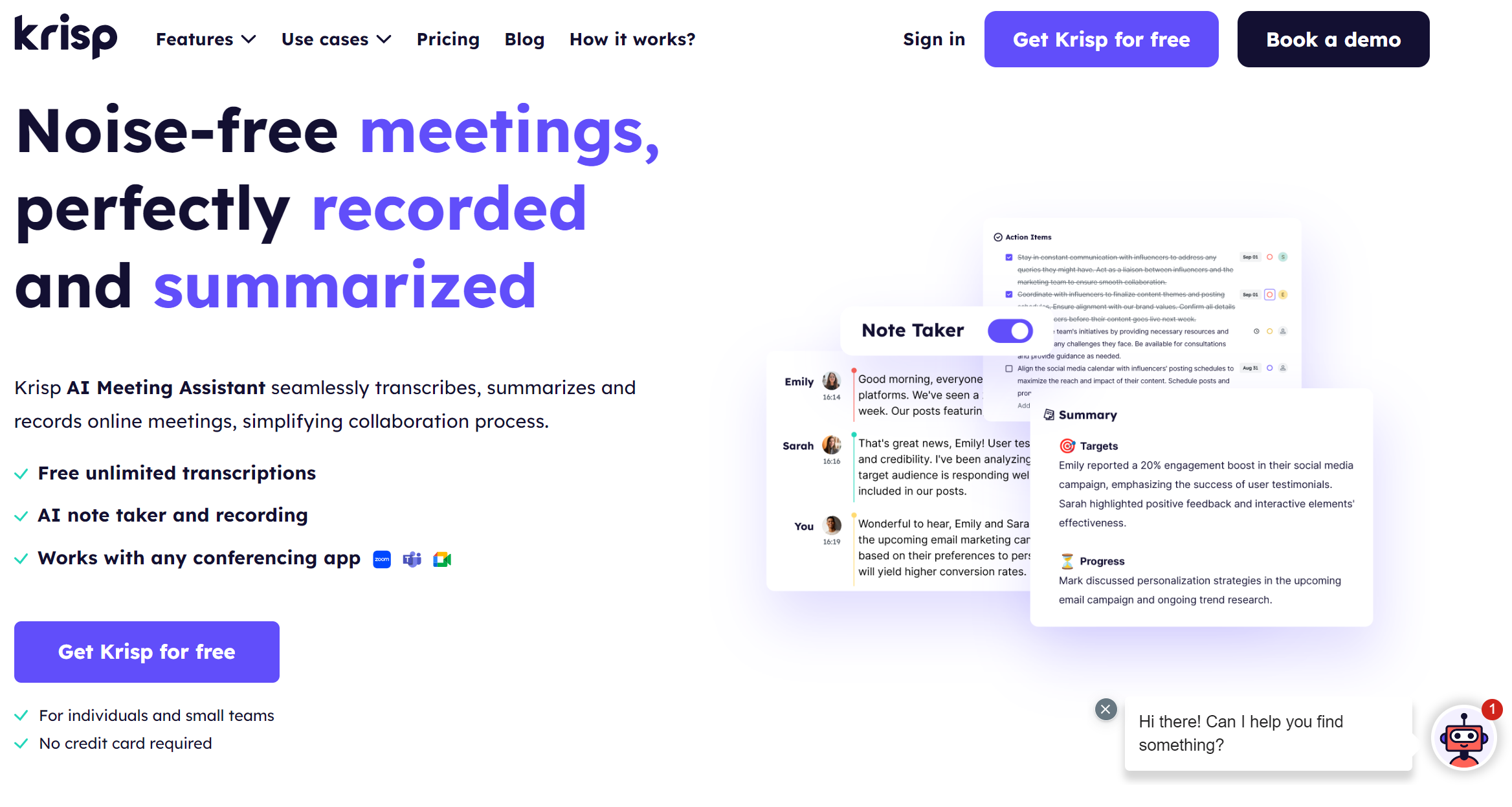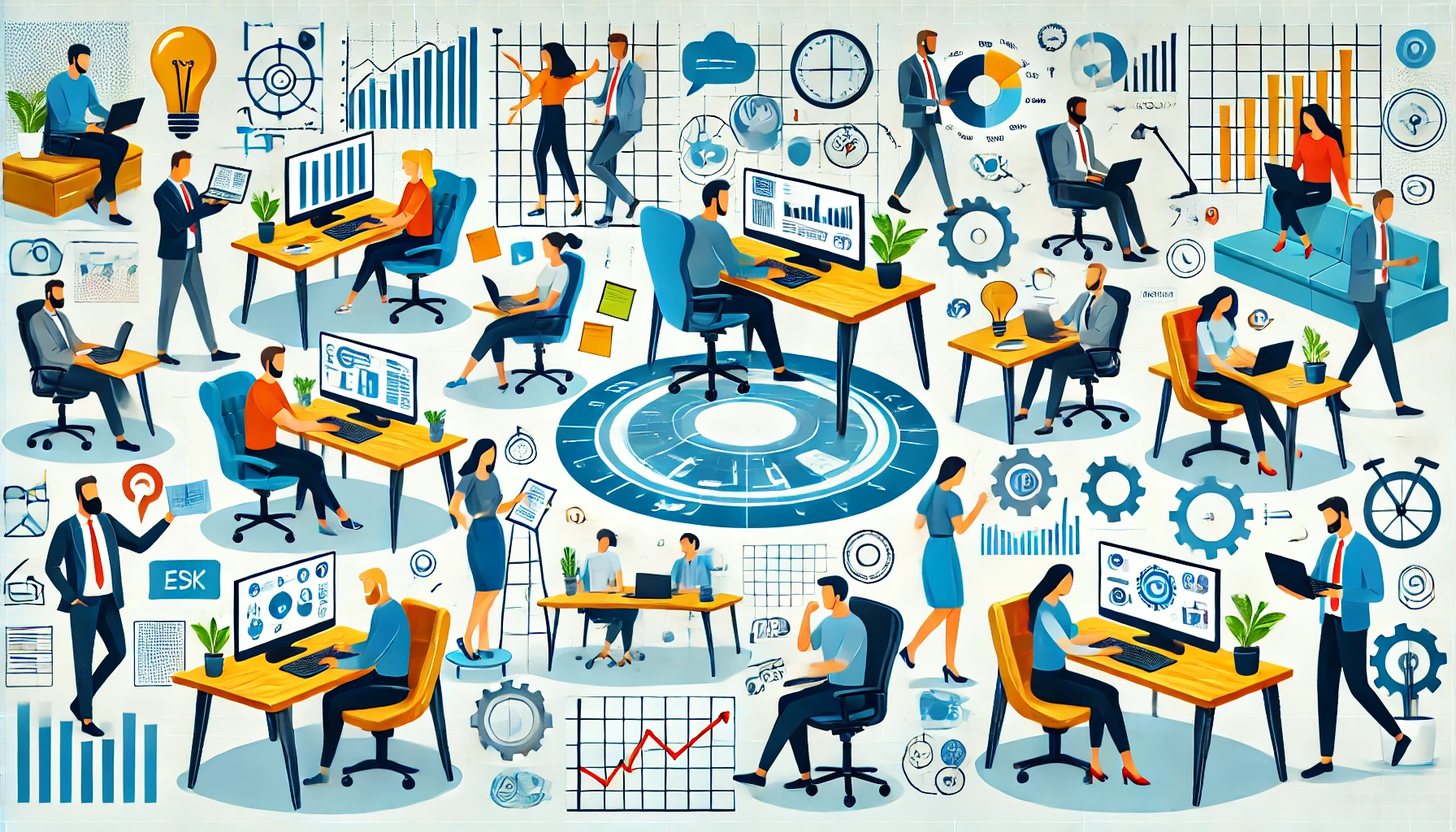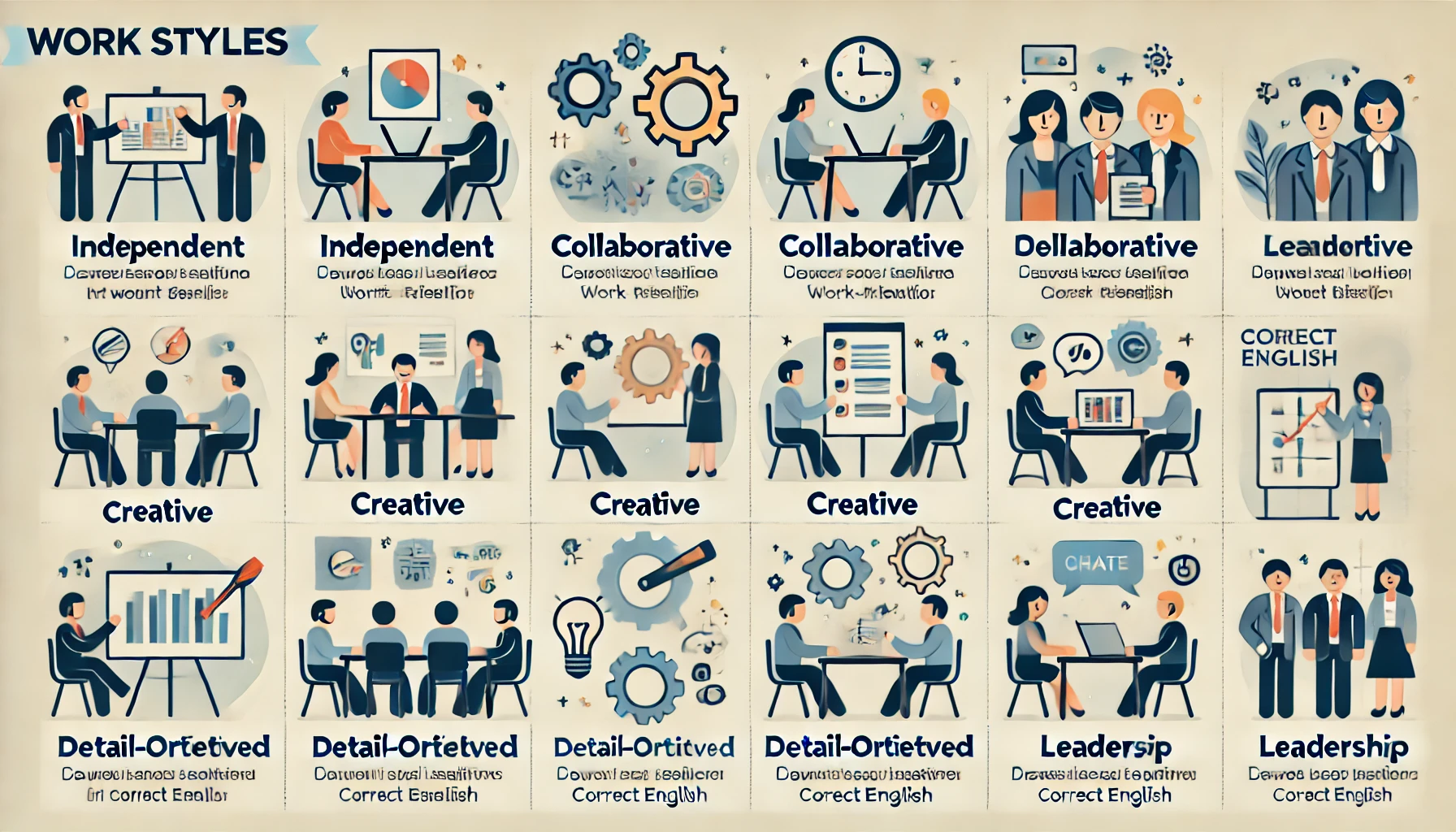How would you describe your work style? Are you a go-getter who thrives under pressure? Or are you a creative thinker who loves brainstorming or a meticulous planner who needs everything right? Understanding your work style can make a world of difference.
Knowing your style can boost productivity and job satisfaction, which is critical for you and your company.
This article will walk you through the work style types, tests, and examples to help identify yours and contribute to a positive organizational culture.
What Is a Work Style?

What is the meaning of work style? It’s how your personality, skills, and experiences shape your approach to your job and relationships. Usually, you’ll hear four main types: logical, supportive, detail-oriented, and idea-oriented. But we’ll dig deeper and discuss six types below.
While we may have a dominant style, we often adopt different styles based on the situation. Specifically, working styles stem from innate personality traits and preferences and are influenced by our lives, previous job experiences, and personal growth. Moreover, they can alter over time.
You might think these styles are similar to personality traits. No, they’re different. Our working style is how we tackle tasks and interact with our coworkers.
According to the American Psychological Association, personality reflects “the enduring characteristics and behavior that comprise a person’s unique adjustment to life, including major traits, interests, drives, values, self-concept, abilities, and emotional patterns.”
Interestingly, work styles were initially perceived as stable traits that developed in childhood. Later, researchers found that these styles are dynamic and influenced by social identities, such as gender and national origin, and environmental constraints, such as physical workspace and remote or hybrid workplace challenges.
Today, the Great Resignation of 2021, also called the Big Quit and the Great Reshuffle, resulted in the lowest job satisfaction in 20 years. And the number of employees willing to find jobs that align with their values is rising worldwide, so the importance of work style is more critical than ever.
How Do You Develop a Working Style?
Now that you know the answer to “What is meant by work style?” let’s look at the main factors shaping how we work. Specifically, this process involves understanding and adapting to your strengths, preferences, and experiences.
Here are the main factors contributing to a unique and compelling work style:
1. Personality: Personality traits like introversion or extroversion and how you handle stress and social interactions.
For example, extroverts are principled, idealistic, objective, and rational. Introverts are independent, influenced by ideas, and often avoid intimacy. Have you watched the passionate talk by the number one New York Times bestselling author Susan Cain about the power of introverts?
2. Skills: Specific abilities, such as critical thinking, problem-solving, communication, technical skills, and time management, acquired through education and experience, training, and practice.
For instance, a degree in engineering fosters logical thinking and structured problem-solving. Thus, engineers develop a style focused on data analysis, precision, and systematic approaches to tasks and projects.
3. Experiences: Previous jobs, projects, and roles that shape our approach to tasks and problem-solving and affect our future jobs. However, employees should also develop new skills that reflect the company’s purpose and workplace culture. Did you know AI and Machine Learning specialists represent the fastest-growing jobs?
For example, experience in customer service can shape a supportive work style. This, in turn, will improve teamwork, boost patience, and facilitate effective communication.
4. Work Environment: The culture, values, and expectations of your workplace. Specifically, values around innovation and effective collaboration foster a creative, idea-oriented working style that strengthens teamwork and ends miscommunication.
For example, a positive workplace environment improves employees’ achievement-striving ability and helps them recover from difficult situations quickly.
5. Feedback: Input from peers, mentors, and supervisors that helps refine our approach. Specifically, feedback fuels performance and shapes a development-focused culture, according to Gallup. Finally, fast and frequent feedback supports agility and retains talent.
Gallup reports that 80% of employees receiving meaningful feedback feel fully engaged.
6. Goals: Personal and professional aspirations that drive our work habits and priorities. Namely, personal aspirations include achieving work-life balance or continuous learning. And professional aspirations involve advancing to a leadership role, earning industry certifications, or contributing to impactful projects.
For example, employees who set daily goals accomplish more and feel better about their work. Thus, even small goals have big power.
Work Style Types and Their Classification
![]()
We often read, “What are the four working styles?” and “What are the six working styles?” So, is it four or six? Typically, you can come across four primary types. However, the concept can be expanded to six to cover a broader range of approaches.
Classification
Various researchers, psychologists, and management experts have developed and refined the concept of working styles and their classifications over time.
For example, the Dominance, Influence, Steadiness, and Conscientiousness (DISC) model, developed by psychologist William Moulton Marston in the 1920s, has dramatically influenced the classification. This is how Marston’s theory categorizes the behavioral expression of emotions.
In addition, a significant contribution comes from Peter Drucker’s management theory. Management theorist Drucker highlighted the importance of creative, not bureaucratic, management and believed managers should be leaders.
Types of Working Styles
Understanding and recognizing diverse work styles helps managers create balanced and motivated teams where different strengths complement each other.
Moreover, it aids employees in finding the exact answer to “Which is the best working style for us?” which will help them become more productive, innovative, happier, and successful.
Let’s get started:
1. Analytical or Logical
Analytical individuals prioritize data, analysis, and structured problem-solving. They effectively break down complex issues into manageable parts and make logical decisions.
These individuals thrive in environments that value transparent processes and detailed analysis. For example, a data analyst at a financial services company analyzes customer transaction data to identify spending patterns, detect fraudulent activities, and provide insights to improve customer service and financial products.
2. Supportive or Collaborative
Supportive individuals appreciate teamwork, collaboration, and helping others. They’re empathetic, good relationship builders, and excel in roles requiring strong interpersonal skills.
These individuals are ideal for work environments where cooperation and team cohesion are vital for success. For instance, human resources managers should improve employee relations, provide conflict resolution, and foster a positive work environment.
3. Detail-Oriented or Methodical
Detail-oriented individuals emphasize precision, organization, and thoroughness. They apply a meticulous approach to task completion, ensuring high accuracy.
These individuals thrive in roles where attention to detail and consistency are paramount. For example, quality assurance specialists meticulously inspect products and identify defects. This is how they ensure adherence to standards to maintain high-quality outcomes and consistency.
4. Idea-Oriented or Creative
Idea-oriented individuals value creativity, innovation, and big-picture thinking. They’re often visionary, and they love to generate new ideas and approaches.
These workers are ideal for environments that encourage out-of-the-box thinking and continuous improvement. For instance, marketing strategists develop innovative campaigns to generate unique marketing ideas and craft compelling strategies to engage audiences and drive brand success.
5. Pragmatic or Realistic
Pragmatic individuals are practical and result-oriented. They prefer efficient, no-nonsense approaches and implement solutions quickly.
These workers are beneficial in fast-paced environments where timely execution is critical. For example, project managers emphasize efficient execution and practical solutions and deliver projects timely. This ensures that objectives are met within time, budget, and resource constraints.
6. Visionary or Strategic
Visionary individuals think long-term and strategically. They’re adept at planning for the future and setting ambitious goals.
These individuals are valuable in leadership roles where guiding the company toward a long-term vision is critical. For instance, chief executive officers (CEO) set long-term goals, envisioning the company’s future direction. Moreover, they develop strategies to drive growth and achieve organizational success.
How Krisp Positively Affects Any Work Style

“It is not the strongest of the species that survives, nor the most intelligent that survives. It’s the most adaptable to change,” said Charles Darwin. Today, when technology is revolutionizing how we live and work, it’s more vital to be adaptable than ever.
Let’s take the increasingly popular remote and hybrid jobs, which require specific skills and qualities to adapt quickly. Did you know that 35% of U.S. workers with the option to work remotely choose to work full-time?
Specifically, remote jobs require strong self-discipline, excellent time management skills, effective communication abilities, adaptability, and proficiency with digital tools.
These qualities enable maintaining productivity and collaboration outside a traditional office environment. The Krisp AI Meeting Assistant helps you quickly adapt your work style to rapid changes in the way we work and collaborate.
Krisp Offers Advantages to Individuals with Any Work Style
In today’s technology-driven workspace, you can’t do without the necessary tools, apps, and platforms, such as note-taking or note-making and meeting recording apps and tools.
Thankfully, Krisp, the leader in Productivity Voice AI, is designed to turn a common workplace into an environment where employees with any working style can thrive.
Specifically, Krisp offers:
- Noise Cancellation in real time to eliminate noise, voice, and echo from meetings and calls
- Free Unlimited Transcriptions to automatically transcribe your meetings
- Automatic, Streamlined Audio Recording with the highest audio quality across all communication apps
- Meeting Notes & Summaries to save the critical discussion points for future reference and collaboration
Since remote and hybrid work environments need tools that enhance communication and productivity, Krisp is vital in shaping the workplace environment in these settings. Specifically:
- Krisp’s Noise-Canceling technology ensures clear communication during virtual meetings, eliminating distractions and enhancing focus. And this is particularly beneficial for detail-oriented and logical workers who rely on precision and clarity.
- Additionally, Krisp’s real-time Transcription and Meeting Summaries streamline note-taking. As a result, idea-oriented individuals can better focus on brainstorming and innovative discussions without missing details.
- Moreover, supportive workers benefit from Krisp’s enhanced communication quality, which fosters stronger virtual relationships and team cohesion.
Thus, by eliminating background disruptions and improving communication quality, Krisp helps individuals with any work style maintain high productivity, efficiency, and team morale.
What Is Work Style Assessment? Work Style Tests & Examples

Ever wondered what’s your working style? First, are you productive and feel more responsible when working independently? Or maybe you like receiving regular feedback on your ideas and getting support to stay on track, right?
What if you like routinely bringing emotion into the workplace or prefer facts? And what about problem-solving? Are you detail-oriented or enjoy looking at the big picture to solve a problem? Finally, are you a hill-taker or hill figure-outer?
Answering these questions will reveal whether you’re independent, cooperative, strategic, or detail-oriented. By the way, Conscientiousness is the number one personality trait employers look for, according to a workplace psychologist.
Let’s get this show on the road.
Work Style Assessment Tests
You can also use tests to find the best answer to the question, “What is your work style?”
1. Myers-Briggs Type Indicator (MBTI)
MBTI is a self-reported personality test including about 94 questions that categorize individuals into four dichotomies: introversion-extroversion, sensing-intuition, thinking-feeling, and judging-perceiving. It helps understand how people perceive the world and make decisions.
Questions include, “How do you get your mental energy?” and “How do you take in information?”
2. DiSC Personality Test
This assessment evaluates behavior using four primary traits: Dominance, Influence, Steadiness, and Conscientiousness. It helps improve teamwork, communication, and productivity. The adaptive DiSC model test takes 15 to 20 minutes and has 80 questions.
Questions include “What’s one thing you’ve done for the team this month?” and “What’s one strength I (or each member) bring(s) to the team?”
3. Big Five Personality Test
Also called OCEAN or CANOE, this test measures five significant dimensions of personality: Openness, Conscientiousness, Extraversion, Agreeableness, and Neuroticism. This assessment helps predict job performance and compatibility with organizational culture. It has 60 questions and takes about five to 10 minutes to complete.
Statements include “I’m the life of the party” and “I have difficulty understanding abstract ideas.”
4. StrengthsFinder (CliftonStrengths Assessment)
This test identifies an individual’s top strengths out of 34 talent themes. It’s used for personal development and career planning. Specifically, this assessment focuses on building strengths rather than improving weaknesses. It consists of 177 questions and takes 30-45 minutes to complete.
Questions include “I’m known for my neatness” and “I have a good sense of humor.”
5. Hogan Personality Inventory (HPI)
HPI assesses personality characteristics that influence job performance. This test helps in recruitment, leadership development, and team building. Specifically, HPI consists of 220 questions and takes 15-20 minutes to complete.
Questions include “I find myself curious about how things operate” and “I like working in a team.”
Work Style Assessment Tests Used by Companies
Often, major companies use their assessment tests to optimize their work processes. Here are some notable ones:
1. Work Style Test IAR
The IAR assessment test features the following attributes: Influence, Adaptability, and Resilience. It helps understand individuals’ ability to influence others, adapt to changing environments, and remain resilient under pressure.
For example, the Style Test IAR could include situational questions like “How do you handle sudden changes in project requirements?” And it offers options ranging from quickly adapting and influencing team direction to struggling with the change.
2. Amazon Assessment
Amazon’s assessment tests help identify candidates who align with the company’s leadership principles and work culture. These tests specifically gauge an individual’s preferences and tendencies in a work environment, such as their approach to problem-solving, teamwork, and handling stress.
Specifically, Amazon’s assessment tests typically take 10-20 minutes to complete and consist of paired statements where employees must choose which one best represents their work style. For example:
- Statement A: “I prefer spending most of my time doing work that uses my current skillset.”
- Statement B: “Sometimes, I ask questions to understand concepts better.”
3. Google Test
Google employs various work style assessment tests to identify creative, innovative, and collaborative candidates. These tests help managers understand how individuals approach problem-solving, teamwork, and adaptability.
Namely, these tests involve a series of statements in which candidates express their level of agreement, ranging from “Strongly Agree” to “Strongly Disagree.” For instance:
- Statement A: “I prefer working in a structured environment.”
- Statement B: “I look forward to learning new things.”
Sum Up
Understanding and leveraging different work styles through assessments like MBTI, DiSC, and StrengthsFinder help align employees with roles that suit their strengths. As a result, companies create a productive and harmonious workplace with well-balanced and adaptable teams.
Moreover, using technology like the Krisp AI Meeting Assistant is beneficial for any work style. Krisp provides real-time Noise Cancellation, Meeting Recording, and exceptionally accurate Transcription and Meeting Summaries. This ensures clear communication, better organization, and increased focus, efficiency, and productivity for remote collaboration.
Frequently Asked Questions
- Logical: Focuses on data, analysis, and structured problem-solving.
- Supportive: Prioritizes teamwork, collaboration, and helping others.
- Detail-Oriented: Emphasizes precision, organization, and thoroughness.
- Idea-Oriented: Values creativity, innovation, and big-picture thinking.
- Openness to Experience: Creativity and curiosity.
- Conscientiousness: Organization and dependability.
- Extraversion: Sociability and assertiveness.
- Agreeableness: Compassion and cooperation.
- Neuroticism: Emotional stability and tendency toward negative emotions.




